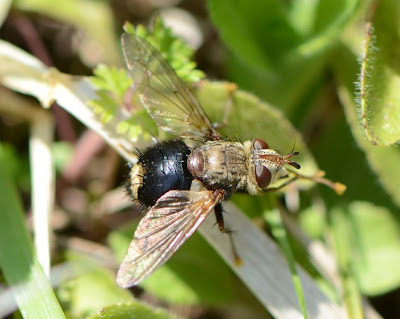Nothing could be further from the truth. The Fly World is filled with diversity and and fascinating behavior. They're endless fodder for intellectual stimulation, and make for beautiful macro photography subjects. On a recent trip to Shawnee State Forest, I turned my lens to a few flies...
 A tiny flowerfly, its eyes endlessly deep pools of blood-red, wallows in a sea of buttercup nectar. This one was small enough to be measured in millimeters, like a robust gnat. A great number of fly species are vital pollinators of our flora, possibly THE biggest group of pollinators.
A tiny flowerfly, its eyes endlessly deep pools of blood-red, wallows in a sea of buttercup nectar. This one was small enough to be measured in millimeters, like a robust gnat. A great number of fly species are vital pollinators of our flora, possibly THE biggest group of pollinators. Many flowerflies mimic the bad guys. They resemble - sometimes to an eerie degree - wasps, bees, hornets, etc. But you can tell they are flies by the huge eyes, greatly reduced antennae, and the one pair of prominent wings (the others have two pairs). Check out this post by Eric Eaton, which features a few thick-headed flies. They mimic wasps to a remarkable degree.
Many flowerflies mimic the bad guys. They resemble - sometimes to an eerie degree - wasps, bees, hornets, etc. But you can tell they are flies by the huge eyes, greatly reduced antennae, and the one pair of prominent wings (the others have two pairs). Check out this post by Eric Eaton, which features a few thick-headed flies. They mimic wasps to a remarkable degree. This one might make you jump, should it unexpectedly buzz into your face. It's a flowerfly that's doing a mighty respectable job of looking like a yellowjacket or some other nasty stinger. There are a number of species, and genera, that resemble this guy and I'm not sure which one it is. That holds true for all of the flies in this post. If anyone does know their specific identity please let me know. I'd love to learn more about them.
This one might make you jump, should it unexpectedly buzz into your face. It's a flowerfly that's doing a mighty respectable job of looking like a yellowjacket or some other nasty stinger. There are a number of species, and genera, that resemble this guy and I'm not sure which one it is. That holds true for all of the flies in this post. If anyone does know their specific identity please let me know. I'd love to learn more about them. This flowerfly, happily chowing away on pussytoes, was very cool. It reminded me of a potter's wasp with its stripes of white on a black body. And to further the ruse, it constantly twitched and arched its abdomen, just as a wasp does.
This flowerfly, happily chowing away on pussytoes, was very cool. It reminded me of a potter's wasp with its stripes of white on a black body. And to further the ruse, it constantly twitched and arched its abdomen, just as a wasp does. Here we have, I believe, a tachinid fly. They look rather menacing, and are. A lot of tachinids - and there is something like 1,900 species in North America - resemble exceptionally ugly house flies. You can tell them by the thick, coarse hairs that bristle from the abdomen. Tachinids are parasitoids; they lay their eggs on hosts such as caterpillars, katydids, or ther insects. The fly grubs then proceed to feed on the living host, ultimately killing it. CLICK HERE for a post mortem of a rare pink katydid that fell victim to a tachinid.
Here we have, I believe, a tachinid fly. They look rather menacing, and are. A lot of tachinids - and there is something like 1,900 species in North America - resemble exceptionally ugly house flies. You can tell them by the thick, coarse hairs that bristle from the abdomen. Tachinids are parasitoids; they lay their eggs on hosts such as caterpillars, katydids, or ther insects. The fly grubs then proceed to feed on the living host, ultimately killing it. CLICK HERE for a post mortem of a rare pink katydid that fell victim to a tachinid. A particularly ferocious tachinid (I think) awaits victims. If you tune your eye to the insect world, you'll begin to notice the staggering number of parasitoid flies and wasps that are out there. They often seem to sit patiently and vigilant, carefully watching for prey. Some of them, especially the wasps, actively patrol the vegetation, searching out victims. Given the magnitude of the army of parasitoids lurking out there, it seems a miracle that any caterpillar or cricket ever makes it to adulthood.
A particularly ferocious tachinid (I think) awaits victims. If you tune your eye to the insect world, you'll begin to notice the staggering number of parasitoid flies and wasps that are out there. They often seem to sit patiently and vigilant, carefully watching for prey. Some of them, especially the wasps, actively patrol the vegetation, searching out victims. Given the magnitude of the army of parasitoids lurking out there, it seems a miracle that any caterpillar or cricket ever makes it to adulthood.
4 comments:
A beautiful site, Jim. I grew uo in southern Ohio--was doing some research on a story I'm writing. Thanks for your help.
Lois Owens Donahue
This helped so much as I just came back from Central America and one of these little guys flew out of my bah (the black and yellow one) and is currently captured inside a candle, and I wanted to know if I should afraid
Thanks Jim, you certainly enhance interest with beautiful photos and writing.
Flies are surprisingly fascinating! From flowerflies mimicking wasps to bristly tachinids as parasitoids, their diversity and roles as pollinators and pest controllers are incredible. There's so much beauty in these often-overlooked insects!
Post a Comment